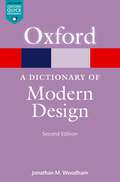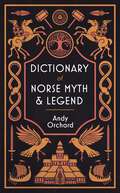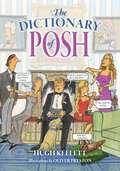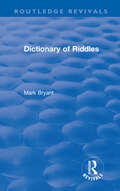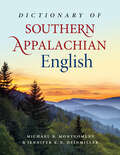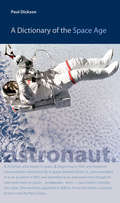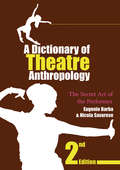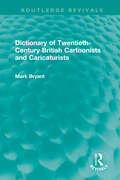- Table View
- List View
Dictionary Of Modern Art
by Matthew BaigellAlphabetically arranged and crossreferenced entries provide background information on major American painters, sculptors, printmakers, and photographers, plus important topics and movements central to American art from the sixteenth century to the present.
Dictionary Of Modern Art
by Matthew BaigellAlphabetically arranged and crossreferenced entries provide background information on major American painters, sculptors, printmakers, and photographers, plus important topics and movements central to American art from the sixteenth century to the present.
A Dictionary of Modern Design (Oxford Quick Reference Online)
by Jonathan WoodhamOver 950 entries From the Arts and Crafts Movement to Postmodernism, Apple to Frank Lloyd Wright, this fascinating dictionary covers the past 160 years of international design, with accessible entries on branding, graphics, industrial design, functionalism, and fashion. New entries on digital design and sustainable design bring the coverage up to date. The dictionary's international focus takes in major movements, key concepts, design terminology, and important design institutions, museums, and heritage sites. The new edition reflects the growing global importance of design, with coverage of India, China, the countries of the Pacific Rim, Eastern Europe and East Asia, and demonstrates how developments in the design of technology influence everyday life, with new entries on fonts, games developers such as Gunpei Yokoi of Nintendo, Android, Samsung, and Blackberry, and a fully revised entry on Apple. The A-Z entries are complemented by an extensive bibliography and a timeline.
A Dictionary of Mutual Understanding: The compelling Richard and Judy Summer Book Club winner
by Jackie CopletonLONGLISTED FOR THE BAILEYS WOMEN'S PRIZE FOR FICTION 2016A BBC RADIO 2 BOOK CLUB PICK 'Memoirs of a Geisha meets The Piano Teacher, in the best way.' InStyleAmaterasu Takahashi has spent her life grieving for her daughter Yuko and grandson Hideo, who were victims of the atomic bomb dropped on Nagasaki in 1945. Now a widow living in America, she believes that one man was responsible for her loss; a local doctor who caused an irreparable rift between mother and daughter. When a man claiming to be Hideo arrives on her doorstep, she is forced to revisit the past; the hurt and humiliation of her early life, the intoxication of a first romance and the realisation that if she had loved her daughter in a different way, she might still be alive today.
Dictionary of Norse Myth & Legend
by Andrew OrchardFrom Loki to Thor, Ragnarok to BeowulfA gripping and truly mesmerising delve into the Norse legendsFrom bestselling books to blockbusting Hollywood movies, the myths of the Scandinavian gods and heroes are part of the modern day landscape.For over a millennium before the arrival of Christianity, the legends permeated everyday life in Iceland and the northern reaches of Europe. Since that time, they have been perpetuated in literature and the arts in forms as diverse as Tolkien and Wagner, graphic novels to the world of Marvel. This book covers the entire cast of supernatural beings, from gods to trolls, heroes to monsters, and deals with the social and historical background to the myths, topics such as burial rites, sacrificial practices and runes.
A Dictionary of Philosophy of Religion, Second Edition
by Charles Taliaferro Elsa J. MartyA Dictionary of Philosophy of Religion is an indispensable resource for students and scholars. Covering historical and contemporary figures, arguments, and terms, it offers an overview of the vital themes that make philosophy of religion the growing, vigorous field that it is today. It covers world religions and sources from east and west. Entries have been crafted for clarity, succinctness, and engagement. This second edition includes new entries, extended coverage of non-Christian topics, as well as revisions and updates throughout.The first edition was named a Choice Outstanding Academic Title of the Year.
A Dictionary of Philosophy of Religion, Second Edition
by Charles Taliaferro Elsa J. MartyA Dictionary of Philosophy of Religion is an indispensable resource for students and scholars. Covering historical and contemporary figures, arguments, and terms, it offers an overview of the vital themes that make philosophy of religion the growing, vigorous field that it is today. It covers world religions and sources from east and west. Entries have been crafted for clarity, succinctness, and engagement. This second edition includes new entries, extended coverage of non-Christian topics, as well as revisions and updates throughout.The first edition was named a Choice Outstanding Academic Title of the Year.
The Dictionary of Posh: Incorporating the Fall and Rise of the Pails-Hurtingseaux Family
by Hugh KellettThe Dictionary of Posh serves as an essential guide to the (ab)use of many English words by the decidedly up-market and the resultant — and endangered — language they speak: Posh. Hugh Kellett hilariously captures the spirit and nuances of those who speak Posh and, allied with Oliver Preston's brilliantly accurate cartoons, this book is the key to understanding and interpreting this language ?— literally with tongue-in-cheek. Hidden within normal English is a separate language still spoken by those born with silver spoons in their mouths. It's called Posh. A word of English can be spelt the same but mean something completely different in Posh. If you say the word 'Mention' in English, people will understand 'Remark upon'; but in Posh this means a large house. Say 'Ace' and speakers of Posh will think you are referring to a cold thing one's butler puts in one's G&T.
Dictionary of Riddles (Routledge Revivals)
by Mark BryantOriginally published in 1990 by Routledge, Dictionary of Riddles is a collection of nearly 1500 of the most cryptic and entertaining riddles from history. Drawn from sources throughout the world, the collection ranges from earthy medieval jokes about fleas, worms and vegetables to the sophisticated puzzles composed by literary figures from Schiller, Swift, Voltaire, Rousseau and Cervantes to Edgar Allan Poe, Lewis Carroll and J.R.R. Tolkien. The book traces the history of riddles from their origins in antiquity through the golden age of the Renaissance, to their decline into the nursery and the first few signs of their modern revival, and draws together all the strands of the riddling art. Dictionary of Riddles received a Special Commendation in Reference Review’s Best Specialist Reference Books of 1990 Awards.
Dictionary of Southern Appalachian English
by Michael B. Montgomery & Jennifer K. N. HeinmillerThe Dictionary of Southern Appalachian English is a revised and expanded edition of the Weatherford Award–winning Dictionary of Smoky Mountain English, published in 2005 and known in Appalachian studies circles as the most comprehensive reference work dedicated to Appalachian vernacular and linguistic practice. Editors Michael B. Montgomery and Jennifer K. N. Heinmiller document the variety of English used in parts of eight states, ranging from West Virginia to Georgia—an expansion of the first edition's geography, which was limited primarily to North Carolina and Tennessee—and include over 10,000 entries drawn from over 2,200 sources. The entries include approximately 35,000 citations to provide the reader with historical context, meaning, and usage. Around 1,600 of those examples are from letters written by Civil War soldiers and their family members, and another 4,000 are taken from regional oral history recordings. Decades in the making, the Dictionary of Southern Appalachian English surpasses the original by thousands of entries. There is no work of this magnitude available that so completely illustrates the rich language of the Smoky Mountains and Southern Appalachia.
Dictionary of Subjects and Symbols in Art
by James HallThe understanding and enjoyment of a work of art depends as much on the story it depicts as on the artist's execution of it. But what were once biblical or classical commonplaces are not so readily recognizable today. This book relates in a succinct and readable way the themes, sacred and secular, on which the repertoire of Western art is based. Combined here in a single volume are religious, classical, and historical themes, figures of moral allegory, and characters from romantic poetry that appeared throughout paintings and sculpture in Western art before and after the Renaissance. More than just a dictionary, this text places these subjects in their narrative, historical, or mythological context and uses extensive cross-referencing to enhance and clarify the meanings of these themes for the reader. The definitive work by which others are compared, this volume has become an indispensable handbook for students and general appreciators alike. This wholly redesigned second edition includes a new insert of images chosen by the author, as well as a new preface and index to highlight the ideas, beliefs, and social and religious customs that form the background of much of this subject matter.
Dictionary of Subjects and Symbols in Art (Icon Editions Ser.)
by James HallThe understanding and enjoyment of a work of art depends as much on the story it depicts as on the artist's execution of it. But what were once biblical or classical commonplaces are not so readily recognizable today. This book relates in a succinct and readable way the themes, sacred and secular, on which the repertoire of Western art is based. Combined here in a single volume are religious, classical, and historical themes, figures of moral allegory, and characters from romantic poetry that appeared throughout paintings and sculpture in Western art before and after the Renaissance. More than just a dictionary, this text places these subjects in their narrative, historical, or mythological context and uses extensive cross-referencing to enhance and clarify the meanings of these themes for the reader. The definitive work by which others are compared, this volume has become an indispensable handbook for students and general appreciators alike. This wholly redesigned second edition includes a new insert of images chosen by the author, as well as a new preface and index to highlight the ideas, beliefs, and social and religious customs that form the background of much of this subject matter.
A Dictionary of the American Avant-Gardes
by Richard KostelanetzFor this American edition of his legendary arts dictionary of information and opinion, the distinguished critic and arts historian Richard Kostelanetz has selected from the fuller third edition his entries on North Americans, including Canadians, Mexicans, and resident immigrants. Typically, he provides intelligence unavailable anywhere else, no less in print than online, about a wealth of subjects and individuals. Focused upon what is truly innovative and excellent, Kostelanetz also ranges widely with insight and surprise, including appreciations of artistic athletes such as Muhammad Ali and the Harlem Globetrotters, and such collective creations as Las Vegas and his native New York City. Continuing the traditions of cheeky high-style Dictionarysts, honoring Ambrose Bierce and Nicolas Slonimsky (both with individual entries), Kostelanetz offers a "reference book" to be treasured not only in bits and chunks, but continuously as one of the ten books someone would take if they planned to be stranded on a desert isle.
A Dictionary of the American Avant-Gardes
by Richard KostelanetzFor this American edition of his legendary arts dictionary of information and opinion, the distinguished critic and arts historian Richard Kostelanetz has selected from the fuller third edition his entries on North Americans, including Canadians, Mexicans, and resident immigrants. Typically, he provides intelligence unavailable anywhere else, no less in print than online, about a wealth of subjects and individuals. Focused upon what is truly innovative and excellent, Kostelanetz also ranges widely with insight and surprise, including appreciations of artistic athletes such as Muhammad Ali and the Harlem Globetrotters, and such collective creations as Las Vegas and his native New York City. Continuing the traditions of cheeky high-style Dictionarysts, honoring Ambrose Bierce and Nicolas Slonimsky (both with individual entries), Kostelanetz offers a "reference book" to be treasured not only in bits and chunks, but continuously as one of the ten books someone would take if they planned to be stranded on a desert isle.
A Dictionary of the History of Medicine
by Anton SebastianThis is a unique, extensively illustrated dictionary of terms, people, events, and dates spanning the entire history of medicine. It is a monumental work of scholarship totaling some 700 double-column pages with a large number of rare and exceptional illustrations from many original sources painstakingly compiled over years of far-searching inquiry involving more than 5,000 books and hundreds of journals. It is a major resource of hard-to-find information about notable medical figures, instruments, conditions, procedures, and dates and a storehouse of captivating anecdotes and background material. The book contains a wealth of material for concise historical introductions to a broad range of subjects and is the sine qua non authority on both well and little known facts of medical history. With this single volume-an unprecedented tour de force representing more than 7,000 hours of exhaustive research-clinicians and researchers from all fields of medicine can quickly and easily find authoritative, detailed definitions and descriptions, with dates, of medical terms and of the people and events contributing to the development of medicine from earliest times to the present day. The entries range widely from such as abacterial pyuria to zygote, including Latin and Greek origins of terms, compact biographies with dates, eponymic information of all kinds, and rarely seen drawings and photographs of antique medical instruments and little-known conditions.
A Dictionary of the History of Medicine
by Anton SebastianThis is a unique, extensively illustrated dictionary of terms, people, events, and dates spanning the entire history of medicine. It is a monumental work of scholarship totaling some 700 double-column pages with a large number of rare and exceptional illustrations from many original sources painstakingly compiled over years of far-searching inquiry involving more than 5,000 books and hundreds of journals. It is a major resource of hard-to-find information about notable medical figures, instruments, conditions, procedures, and dates and a storehouse of captivating anecdotes and background material. The book contains a wealth of material for concise historical introductions to a broad range of subjects and is the sine qua non authority on both well and little known facts of medical history. With this single volume-an unprecedented tour de force representing more than 7,000 hours of exhaustive research-clinicians and researchers from all fields of medicine can quickly and easily find authoritative, detailed definitions and descriptions, with dates, of medical terms and of the people and events contributing to the development of medicine from earliest times to the present day. The entries range widely from such as abacterial pyuria to zygote, including Latin and Greek origins of terms, compact biographies with dates, eponymic information of all kinds, and rarely seen drawings and photographs of antique medical instruments and little-known conditions.
Dictionary of the History of Science (PDF)
by William F. Bynum E. Janet Browne Roy PorterFor readers interested in the development of major scientific concepts and the role of science in the western world, here is the first conceptually organized historical dictionary of scientific thought. The purpose of the dictionary is to illuminate this history by providing a concise, single volume reference book of short historical accounts of the important themes, ideas, and discoveries of science. Its conceptual approach differentiates the dictionary from previous reference works such as books of scientific biography and makes it a convenient manual both for the general reader and for scientists interested in the origin of concepts in their own and other scientific fields.Originally published in 1982.The Princeton Legacy Library uses the latest print-on-demand technology to again make available previously out-of-print books from the distinguished backlist of Princeton University Press. These editions preserve the original texts of these important books while presenting them in durable paperback and hardcover editions. The goal of the Princeton Legacy Library is to vastly increase access to the rich scholarly heritage found in the thousands of books published by Princeton University Press since its founding in 1905.
Dictionary of the Holocaust: Biography, Geography, and Terminology
by Eric J. Epstein Philip RosenThis concise, easy-to-use resource on the Holocaust is rich in factual and statistical information, and provides a comprehensive compilation of the people and terms that are essential for an understanding of the Holocaust. In 2,000 entries, it profiles major personalities, covers concentration and death camps, cities and countries, and significant events. Also included are important terms translated from German, French, Polish, Yiddish, and twelve other languages. Biographical entries give a brief history, the person's significance, and their historical context. Geographical entries pinpoint exact locations using other cities or countries as landmarks, and give the number of Jewish inhabitants before Nazi occupation, and the percentage of Jews killed. Historical background is provided for such events as Kristallnacht and the Warsaw Ghetto Uprising, and entries on concentration and death camps give details on the nationalities interned, the camp's specific location, and its history.This reference is impressive in its scope and includes major perpetrators, bystanders, collaborators, victims, rescuers such as Righteous Gentiles, Jewish ghetto fighters, and partisans. It also explores the role of women and the complicity of physicians and industrialists during the Holocaust more fully than any other reference. This dictionary provides the information needed by students whose understanding of the Holocaust is limited by the absence of a single accessible research text.
Dictionary of the Political Thought of the People's Republic of China
by Henry Yuhuai HeFar more than a simple glossary, this unique resource provides a detailed lexicography of political and social life in China today, and deepens our understanding of the last twenty years of enormous change in the People's Republic. Each of the 1,600 entries (1) is rendered in Chinese characters; (2) is alphabetized according to pinyin, the Chinese phonetic alphabet; (3) is translated into English; and (4) is explained in terms of the situation in which it first appeared and how its meaning shifted over time. In addition to the main body of definitions and annotations, there are three appendices, abbreviations, a name index, and a bibliography.
Dictionary of the Political Thought of the People's Republic of China
by Henry Yuhuai HeFar more than a simple glossary, this unique resource provides a detailed lexicography of political and social life in China today, and deepens our understanding of the last twenty years of enormous change in the People's Republic. Each of the 1,600 entries (1) is rendered in Chinese characters; (2) is alphabetized according to pinyin, the Chinese phonetic alphabet; (3) is translated into English; and (4) is explained in terms of the situation in which it first appeared and how its meaning shifted over time. In addition to the main body of definitions and annotations, there are three appendices, abbreviations, a name index, and a bibliography.
A Dictionary of the Space Age (New Series in NASA History (PDF))
by Paul DicksonThe launch of Sputnik 1 in 1957 ushered in an exciting era of scientific and technological advancement. As television news anchors, radio hosts, and journalists reported the happenings of the American and the Soviet space programs to millions of captivated citizens, words that belonged to the worlds of science, aviation, and science fiction suddenly became part of the colloquial language. What’s more, NASA used a litany of acronyms in much of its official correspondence in an effort to transmit as much information in as little time as possible. To translate this peculiar vocabulary, Paul Dickson has compiled the curious lingo and mystifying acronyms of NASA in an accessible dictionary of the names, words, and phrases of the Space Age.Aviators, fighter pilots, and test pilots coined the phrases "spam in a can" (how astronauts felt prelaunch as they sat in a tiny capsule atop a rocket booster); "tickety-boo" (things are fine), and "the Eagle has landed" (Neil Armstrong’s famous quote when Apollo 11 landed on the Moon).This dictionary captures a broader foundation for language of the Space Age based on the historic principles employed by the Oxford English Dictionary and Webster’s New Third International Dictionary. Word histories for major terms are detailed in a conversational tone, and technical terms are deciphered for the interested student and lay reader. This is a must-own reference for space history buffs.
A Dictionary of the Space Age (New Series in NASA History (PDF))
by Paul DicksonThe launch of Sputnik 1 in 1957 ushered in an exciting era of scientific and technological advancement. As television news anchors, radio hosts, and journalists reported the happenings of the American and the Soviet space programs to millions of captivated citizens, words that belonged to the worlds of science, aviation, and science fiction suddenly became part of the colloquial language. What’s more, NASA used a litany of acronyms in much of its official correspondence in an effort to transmit as much information in as little time as possible. To translate this peculiar vocabulary, Paul Dickson has compiled the curious lingo and mystifying acronyms of NASA in an accessible dictionary of the names, words, and phrases of the Space Age.Aviators, fighter pilots, and test pilots coined the phrases "spam in a can" (how astronauts felt prelaunch as they sat in a tiny capsule atop a rocket booster); "tickety-boo" (things are fine), and "the Eagle has landed" (Neil Armstrong’s famous quote when Apollo 11 landed on the Moon).This dictionary captures a broader foundation for language of the Space Age based on the historic principles employed by the Oxford English Dictionary and Webster’s New Third International Dictionary. Word histories for major terms are detailed in a conversational tone, and technical terms are deciphered for the interested student and lay reader. This is a must-own reference for space history buffs.
A Dictionary of Theatre Anthropology: The Secret Art of the Performer
by Eugenio Barba Nicola SavareseFirst Published in 2005. A Dictionary of Theatre Anthropology subtly juxtaposes visual demonstrations of the performer’s craft, from a wealth of Eastern and Western sources. More than just a dictionary, this is a handbook for theatre practitioners and a guide for students and scholars of transcultural performance. It is the result of many years of research conducted by Eugenio Barba and the International School of Theatre Anthropology (ISTA) based in Denmark, and is now a classic foundational text. Whereas most Western research is concerned with naturalism and psychological realism in acting, the Dictionary focuses on the actor’s arduous and eclectic craft. The Dictionary aims to expand our knowledge of the possibilities of the scenic body, and of the spectator’s response to the dynamics of performance. The Dictionary has practical sections on balance, opposition and montage among other techniques, and discusses issues including The Text and the Stage, The Dilated Body and Energetic Language. This revised edition includes: three new chapters on Eurasian Theatre, Exercises and Organicity; 50 new photographs showing the performer’s craft in black and white and colour; and, for the first time, a useful bibliography and index.
A Dictionary of Theatre Anthropology: The Secret Art of the Performer
by Eugenio Barba Nicola SavareseFirst Published in 2005. A Dictionary of Theatre Anthropology subtly juxtaposes visual demonstrations of the performer’s craft, from a wealth of Eastern and Western sources. More than just a dictionary, this is a handbook for theatre practitioners and a guide for students and scholars of transcultural performance. It is the result of many years of research conducted by Eugenio Barba and the International School of Theatre Anthropology (ISTA) based in Denmark, and is now a classic foundational text. Whereas most Western research is concerned with naturalism and psychological realism in acting, the Dictionary focuses on the actor’s arduous and eclectic craft. The Dictionary aims to expand our knowledge of the possibilities of the scenic body, and of the spectator’s response to the dynamics of performance. The Dictionary has practical sections on balance, opposition and montage among other techniques, and discusses issues including The Text and the Stage, The Dilated Body and Energetic Language. This revised edition includes: three new chapters on Eurasian Theatre, Exercises and Organicity; 50 new photographs showing the performer’s craft in black and white and colour; and, for the first time, a useful bibliography and index.
Dictionary of Twentieth-Century British Cartoonists and Caricaturists (Routledge Revivals)
by Mark BryantBritish cartoonists and caricaturists are renowned worldwide. Originally published in 2000, this indispensable handbook offers a unique ‘who’s who’ of all the major artists working in Britain in the twentieth century and contains nearly 500 entries. Extensively illustrated, the book provides information on the work of artists such as Steve Bell, Gerald Scarfe, Posy Simmonds, Ronald Searle, Trog, mac and Larry as well as such past masters as David Low, Vicky, H. M. Bateman, Illingworth, Heath Robinson and more. The dictionary concentrates primarily on political cartoonists, caricaturists and joke or ‘gag’ cartoonists, actively working for the main Fleet Street national dailies and weeklies from 1900 to 1995. Each entry is cross-referenced and provides a concise biographical outline with an account of the artist’s style, influences and preferred medium. Where relevant the entry includes suggestions for further reading and notes solo exhibitions, books illustrated and works held in public collections. The Dictionary of Twentieth-Century British Cartoonists and Caricaturists offers an insight into the lives of satirical artists working during a century that provoked cartoonists and caricaturists to a pitch of comic and artistic invention that has rarely been matched.

